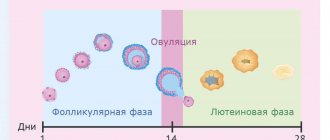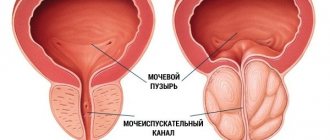Authors of the article: Candidate of Medical Sciences O.Yu. Ermolaev
Experienced gynecologist, physiotherapist-health resort E.K. Ermolaeva
Make an appointment
Here we are cured of a follicular ovarian cyst, rather than trying one drug after another!
From patient reviews
FOLLICULAR OVARIAN CYST is a benign ovarian cyst that forms from the dominant (largest) follicle when it reaches 3.0 cm in diameter or more, in the absence of ovulation (rupture of the follicle and release of the egg).
| Photo of a follicular ovarian cyst 8 cm in diameter on a 3D ultrasound before treatment in our Clinic |
Follicular ovarian cysts account for 83% of all ovarian cysts.
Follicular ovarian cyst occurs predominantly in women of childbearing age, but can occur during the first 5 years of menopause.
Sometimes a follicular cyst is detected in fetuses and newborns.
A follicular ovarian cyst never becomes malignant (“does not turn into cancer”).
| For regularly occurring follicular ovarian cysts, it is IMPORTANT to choose the RIGHT direction in treatment! Everything you need to know about the right direction in successfully treating a follicular cyst WITHOUT HORMONES, see HERE: |
- CAUSES of follicular ovarian cyst
- Follicular ovarian cyst and PREGNANCY
- SYMPTOMS of follicular ovarian cyst
- COMPLICATIONS of follicular ovarian cyst
- TREATMENT of follicular ovarian cyst
- PREVENTION of follicular ovarian cyst
- PHOTO of follicular ovarian cyst
Treatment of follicular cysts by appointment by multi-line phone 8 (800) 500-52-74 (calls within Russia are free), or +7 (for calls abroad).
| ONLINE gynecologist here. REGISTER ONLINE for treatment here. REGISTER online for treatment Booking a course by phone (calls within Russia are free). |
Sign up
Reviews about the treatment
M.Kh., Nalchik
Every month a follicular cyst appeared. I was treated with duphaston and utrozhestan, and was sent for surgery twice, but I got worse and worse. And only you cured it for me with herbs and procedures.
A.I., Pyatigorsk
Gentle treatment without hormones, without escalating the situation with a detailed explanation. You are such a bright Clinic. You want to be consulted and observed.
Treatment of follicular ovarian cyst reviews
Mechanism of formation of follicular ovarian cyst
In response to physiological processes that occur in a woman’s body, functional cysts arise. Follicular cysts, corpus luteum cysts, and thecal lutein cysts most often form in the ovaries.
Follicular cysts are functional ovarian cysts. They develop due to the fact that during the maturation of the follicle it does not rupture. Their diameter can be from three to eight centimeters. As a rule, follicular cysts appear on one of the ovaries and do not manifest themselves in any way. Only a large follicular cyst can be detected during a gynecological examination. Typically, within the next ovarian cycle or two months, most ovarian follicular cysts regress.
Corpus luteum cysts also develop in the ovaries. Their formation occurs in the second (luteal) phase of the cycle due to an increase in the corpus luteum or hemorrhage into it. They are called hemorrhagic corpus luteum cysts. These cysts do not regress. They cause pain in the lower abdomen on the corresponding side and a delay in menstruation. When a corpus luteum cyst ruptures, patients experience acute pain in the lower abdomen. If in the second phase of the cycle a bimanual gynecological examination and ultrasound are performed, then signs of hemoperitoneum can be detected.
Thecal lutein cysts form on both ovaries. They are small in diameter and filled with a light, straw-colored liquid. The reason for their formation may be an abnormally high level of human chorionic hormone, which occurs during stimulation of the ovaries with drugs containing synthetic hCG. These cysts can also appear during treatment with clomiphene, chorionic carcinoma and hydatidiform mole.
Prevention
To reduce the risk of developing ovarian cysts, women are advised to:
- undergo regular preventive examinations with an obstetrician-gynecologist and promptly treat diseases of the genitourinary organs;
- adhere to the principles of rational nutrition;
- use contraceptives to avoid abortions; correct endocrine disorders in a timely manner;
- do not use COCs or take medications without a doctor’s prescription.
If a functional cyst is discovered during the examination, it cannot be ignored and the recommendations of the treating obstetrician-gynecologist must be strictly followed.
Epidemiology of ovarian cysts
Statistics show that seventy-five percent of ovarian cysts that occur in women of reproductive age are functional, and twenty-five percent of cystic formations are tumors. Functional ovarian cysts develop at any age, but they most often occur between puberty and menopause. Since on the eve of menopause there is increased stimulation of the ovary by gonadotropins, this contributes to the fairly frequent formation of functional cysts. In women who smoke, the risk of developing functional ovarian cysts doubles.
Signs
There may be no symptoms of a functional cyst (or other ovarian cysts) initially. Sometimes women tell their doctor that they:
- heaviness and/or nagging pain appeared in the lower abdomen. The intensity of sensations usually increases during and after sexual intercourse, as well as during physical activity;
- the cycle was disrupted, including intermenstrual bleeding from the genital tract;
- the abdomen has increased in volume (this happens if the cyst has acquired significant size).
Symptoms of follicular ovarian cyst
Depending on the type of functional ovarian cyst, its symptoms can be identified. As is known, follicular ovarian cysts occur in most cases without any symptoms. They sometimes cause irregularities in the menstrual cycle, its reduction or increase in intermenstrual intervals. In the presence of large follicular cysts, patients are bothered by severe pain in the pelvic area and dyspareunia.
Unlike a follicular cyst, in the presence of a corpus luteum cyst, local pelvic pain, amenorrhea or delayed menstruation occurs. Acute abdominal pain occurs due to hemorrhage into a corpus luteum cyst or rupture of a follicular cyst.
An accurate diagnosis can only be made after a comprehensive examination of the patient. Thus, during ultrasonography, follicular cysts usually have a diameter of less than eight centimeters, they are single-chamber and thin-walled, their contents are homogeneous and hypoechoic. At the same time, corpus luteum cysts are usually larger than follicular cysts, they are hard and solid during palpation. Their echostructure is heterogeneous.
In order to find out the nature of a functional ovarian cyst and exclude or confirm the malignant nature of the neoplasm, patients are examined for the level of tumor marker CA-125. Although its level may be elevated in epithelial ovarian malignancies, CA-125 is by no means a screening test because it is not sensitive or specific. In addition, on the eve of treatment of follicular ovarian cysts, it is necessary to carry out their differential diagnosis with ectopic pregnancy, pelvic inflammatory diseases, tubo-ovarian abscesses, endometriosis, uterine fibroids and ovarian tumors.
Causes of pain
If an ovarian cyst hurts, this most often indicates the occurrence of a number of problems or complications of the condition. If you ignore the gynecologist's recommendations, discomfort may appear during:
- Active sex.
- Excessive physical activity.
- Injuries and impacts to the pelvic area.
If a woman followed all the recommendations, then the appearance of pain may indicate:
- Changing capsule sizes.
- Cyst rupture.
- Twist the legs.
These conditions require emergency intervention and constant medical monitoring, so if discomfort occurs, you should immediately seek help.
Complications of follicular ovarian cyst
Despite the fact that in most cases, ovarian follicular cysts are asymptomatic, they can cause complications.
Ovarian torsion occurs when there is a sudden change in body position (during sexual intercourse, training sessions, or a fall). Regardless of the size of the follicular cyst, either partial torsion (one hundred and eighty degrees) or complete torsion of the ovary can occur. At this moment, compression or torsion of the vessels and nerve fibers that nourish and innervate the ovary occurs.
When ovarian torsion occurs, sudden acute colicky pain occurs in the right or left groin area or lower abdomen. It is accompanied by nausea and vomiting, as well as a feeling of fear, dizziness, weakness and cold sweat and hypotension. Body temperature often rises, intestinal activity stops, stool retention occurs, and bloating occurs. The pain intensifies when the patient is in a forced position and does not subside at rest.
All these moments (twisting of the ovary and its complete torsion) in the presence of a follicular cyst (functional or retention ovarian cyst), as a rule, occur in the presence of cystic formations, the diameter of which is from five to nine centimeters. In case of ovarian torsion, emergency surgery is performed.
When a follicular cyst ruptures, the patient experiences a piercing (dagger) pain in the lower abdomen, forcing her to instantly take a bent position. She experiences nausea and vomiting, as well as dizziness, weakness and cold sweats, and fainting.
If a follicular cyst ruptures in the place where the ovarian vessels are located, sudden hemorrhage into the ovary, as well as bleeding into the abdominal cavity or pelvis, is possible. This condition is called ovarian apoplexy. It occurs in most cases during sexual intercourse. The clinical picture depends on the amount of blood loss and consists of general signs of hemorrhagic shock: weakness, loss of consciousness, pale skin, tachycardia and hypotension.
The decision on the choice of treatment method is made depending on the degree of hemorrhagic shock, the state of the blood coagulation system, as well as the subjective state of the patient. In most cases, surgical intervention is resorted to.
How to relieve pain before going to the medical center
If pain with a left ovarian cyst greatly affects the quality of life, then before contacting a specialist, you can use painkillers. Painkillers are most often used in combination with antispasmodics:
- Ibuprofen.
- No-shpa.
- Paracetamol.
- Spazmolgon.
Additionally, you can use sedatives that will reduce the intensity of pain and help relax the muscles. In some cases, it is possible to use a heating pad, which is placed at the location of the cyst. This allows you to relieve spasm and further relax the muscles.
But you should not resort to self-medication and simply dull the pain. Based on the strength and nature of the manifestations, the doctor can determine:
- The patient's condition.
- Presence of complications.
- Localization of the cyst.
When pain is dulled by taking medications, this diagnostic method becomes ineffective, so immediately before visiting a doctor you should stop taking pills.
Follicular ovarian cyst. Treatment
Treatment of patients suffering from functional ovarian cysts is directly dependent on their age and the nature of the cyst. Considering that if the ovaries or ovarian neoplasms are palpated in premenopause or postmenopause, they have a high potential for malignancy, they are subject to active management. For this purpose, exploratory laparoscopy or laparotomy, oophorectomy or adnexectomy are used.
If the patient is of reproductive age and has a follicular ovarian cyst, the diameter of which is more than eight centimeters for more than sixty days, and has a complex ultrasound structure, then she is indicated for diagnostic (explorative) laparoscopy or laparotomy and ovarian cystectomy.
In the case when a patient of reproductive age has a follicular ovarian cyst with a diameter of less than six centimeters, she is monitored for two months or for this period of time treatment with oral contraceptives is prescribed in order to suppress the stimulating effect of gonadotropins on the ovaries and the cyst. This is also a method of preventing the recurrence of ovarian follicular cysts in the future. In the event that the cysts do not regress within sixty days of treatment or observation, the patient is recommended to undergo a control ultrasound examination and explorative laparoscopy, as well as ovarian cystectomy.
Diagnostics
Typically, an ovarian cyst is discovered randomly during a routine examination. The doctor prescribes:
- ultrasound examination of the pelvic organs;
- clinical blood test;
- blood test for hCG (to exclude pregnancy);
- smear microscopy;
- analysis to determine the tumor antigen CA-125.
If there is a suspicion of complications, additional diagnostic laparoscopy, puncture of the posterior vaginal vault, computed tomography (CT) or magnetic resonance imaging (MRI) may be required.
Sanatorium treatment of follicular ovarian cyst
Successful treatment of follicular whale of the ovary is carried out in sanatoriums where the following physiotherapeutic methods are used:
- Oxygen therapy, which is performed with modulation of brain rhythms, successfully helps normalize the processes of excitation and inhibition in the cerebral cortex, as well as in subcortical structures. It eliminates jet lag – asynchronosis – and has a general healing effect.
- The exogenous alpha rhythm modulates the human brain's own alpha rhythm. This calms the nervous system and helps normalize the neuroendocrine regulation of the functions of the ovaries, adrenal glands and thyroid gland.
- Such modern physiotherapeutic procedures as electromagnetophoresis, sonophoresis, magnetophoresis of drugs with a running magnetic field, as well as SMT phoresis, purposefully deliver homeopathic drugs to the tissues of the ovaries and other endocrine organs, as well as normalize metabolic processes.
- Homeopathic medicines have a systemic cleansing effect. They normalize metabolism at the cellular and tissue level, stimulate ovarian function and restore hormonal homeostasis, regular and timely ovulation, as well as the thickness and structure of the endometrium during ovulation.








